

The Mongolian prime minister has shaken up the government and looks to amend the constitution to transform the semi-presidential republic into a parliamentary one. These decisions were coupled with mass protests that engulfed Ulaanbaatar in December. The protests were perceived as a test for Mongolian democracy, which is considered a unique phenomenon in the region. Situated between two major authoritarian states – Russia and China – Mongolia has successfully maintained not only its neutrality but also its democratic system, which has been ensuring that its citizens enjoy all of the fundamental freedoms for 30 years already. Today, Russia, finding itself in international isolation, turned its thoughts to its southern neighbor. Human rights activists deplore the decline of democratic freedoms, and sources warn that Russian secret service agents have become active in Ulaanbaatar.
Content
From a coal riot to a «leaflet protest»
Mongolian democracy as a phenomenon
A case of successful transit
Prerequisites for democracy
Why democracy is losing ground in Mongolia
China – Mongolia – Russia
The future of Mongolian democracy
From a coal riot to a «leaflet protest»
Sukhbaatar Square, Ulaanbaatar's main square in front of the Government Palace is patchy with hundreds of leaflets. They were placed on the pavement tiles and then soaked with water: a perfect glue in severe Mongolian frosts. In December 2022, protesters left many messages on the square: “Bribery and corruption are treason”, “Natural resources belong to the people”, “We are poor citizens of a rich country”, “The people are furious and will fight”, and more.
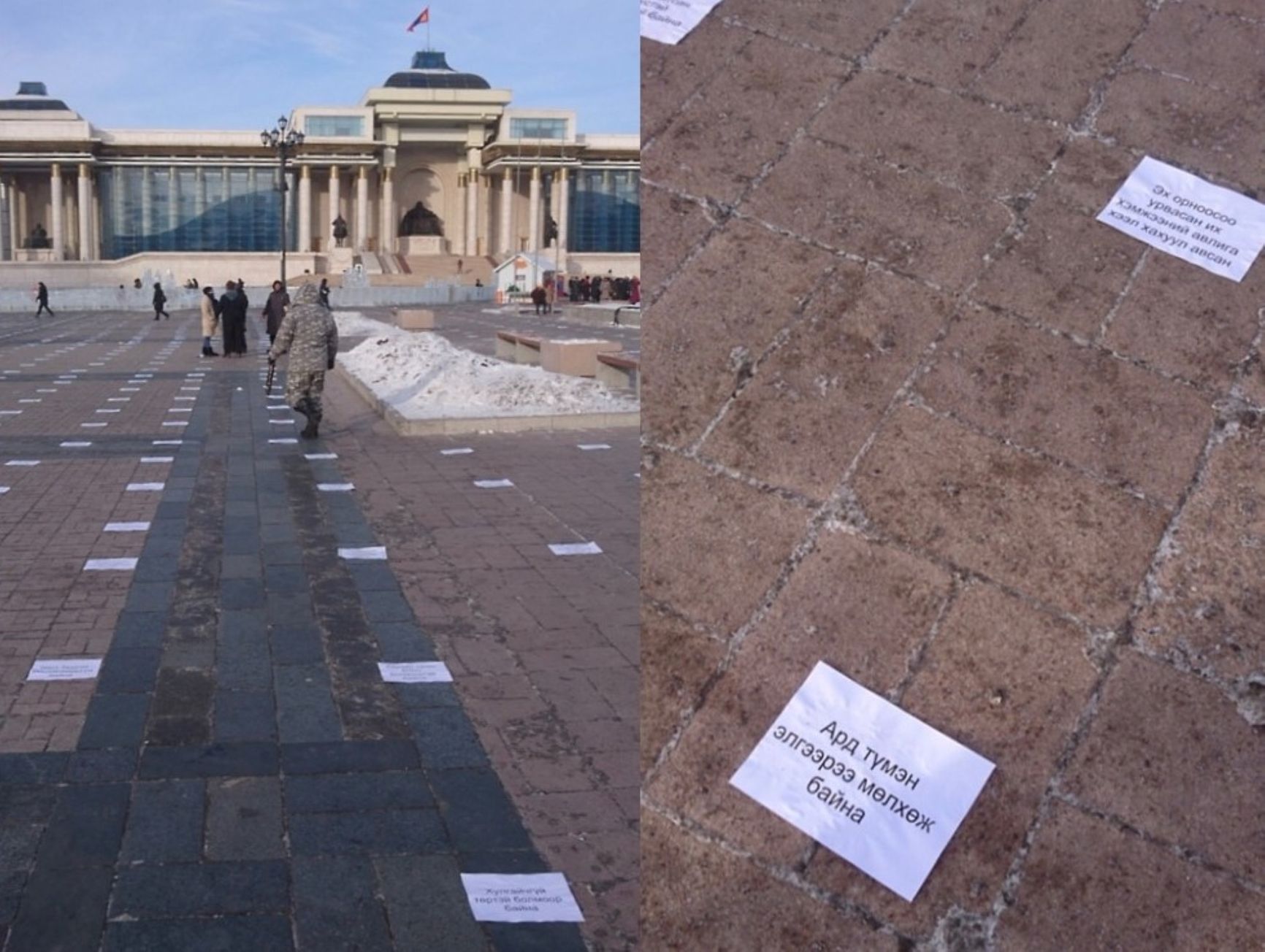
Sukhbaatar Square in front of the Government Palace. January 2023
Protesters demanded punishment for those responsible for stealing massive amounts of coal en route to China and wanted to put an end to corruption and theft of natural resources. The nation was particularly outraged to see corruption on such a scale against the backdrop of a severe economic crisis. Thousands of people gathered in the square, which is a huge number for a country with a population of under 3.5 million people.
Prime Minister Luvsannamsrain Oyun-Erdene exposed the corrupt coal scheme last spring. However, the protests in Ulaanbaatar did not flare up until December, when the scale of the embezzlement came to light. Local media reported discrepancies in Mongolian and Chinese customs service data suggesting that Beijing could have received over 6.5 million tonnes of coal illegally, bypassing customs. The embezzled amount fluctuated from $11 to $17 billion, which corresponds to coal revenue obtained in five to eight years. The Mongolian government stated the theft of 385,000 tonnes of coal.
On December 5, protesters attempted to storm the Government Palace, broke the gates, and set fire to the fir trees. The authorities showed lenience, engaging in a dialog with the protesters, which was the main contributing factor that allowed to resolve the “street” phase of the conflict and ensure its peaceful development. On December 8, the prime minister met with the protested and promised to solve the problem of coal theft once and for all.
The Mongolian cabinet decided to declassify nine contracts linked to the state-owned coal producer Erdenes Tavantolgoy, which the protesters blamed for the coal theft. The lifting of the secrecy will allow the anti-corruption agency to investigate and the public to examine the documents. The Mongolian government has also decided to abandon this type of classified agreement for good. Twenty-two criminal cases were opened over the theft of coal, and several suspects were detained, including the former Erdenes Tavantolgoy COO. More than 30 officials are still being investigated.
Although mass protests in Mongolia stopped in late December, activists still gather in small groups of ten or twenty people, mostly in the afternoon and evening. Meanwhile, the frozen leaflets “protest” around the clock, reminding the authorities of their commitments. “We need civilian control to see through the investigation to its conclusion and bring the perpetrators to justice,” protesters demand. They believe that the uncovered violations could be only the tip of the iceberg and that high-ranking corrupt officials may evade accountability.
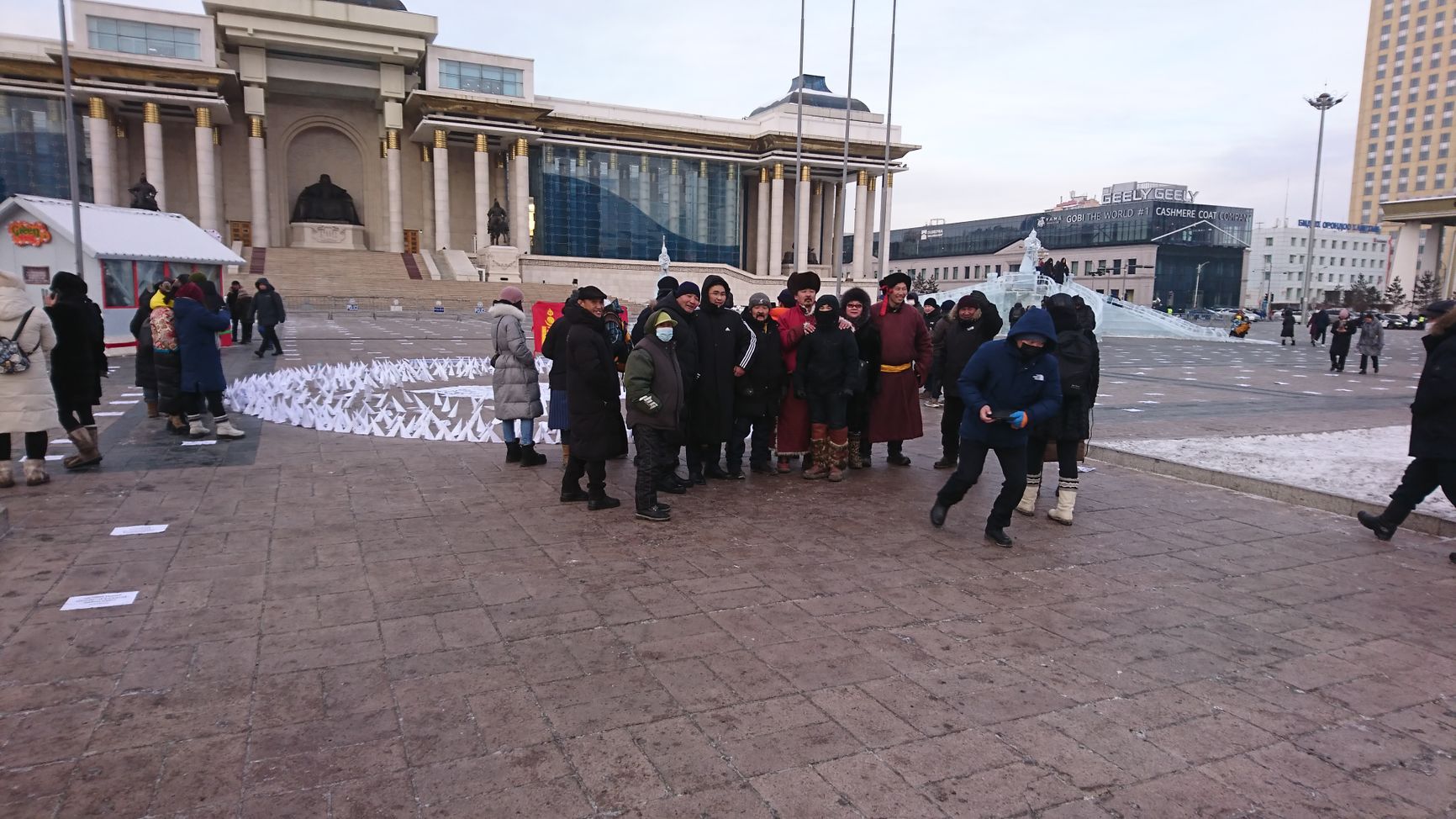
Protesters in front of the Government Palace. Ulaanbaatar, January 2023
Former Mongolian Minister of Finance Ganhuyag Chuluun fears the same. He is concerned that the government offers tenders to affiliated companies, with quotes exceeding market prices three- or fourfold. Customs officers register coal carriers crossing the border as empty, while the conspirators smuggle huge volumes of coal south to Chinese straw firms.
“We are pulling at a thread in which coal is sold to Chinese straw firms that are in fact ours at a very low price and then resold at market price. We must ensure that the knot is unraveled,” Chuluun explained.
Political scientist Margarita Zavadskaya interprets the events in Mongolia as typical anti-corruption, anti-oligarch protests that often occur in democracies, especially young ones. “However, I am hesitant to call Mongolia a ‘young democracy’ because of the pejorative connotation. In reality, the country has already exceeded its democratic transition targets,” says Zavadskaya.
Mongolian democracy as a phenomenon
Political scientists perceive the current Mongolian regime as truly democratic, and international organizations monitoring political and civil liberties around the world share this perspective. International NGO Freedom House ranked Mongolia as a free country with a score of 84 out of 100 points in its 2022 Global Freedom Index, which is one point higher than the US and much higher than Russia, which earned a meager 16 out of 100.
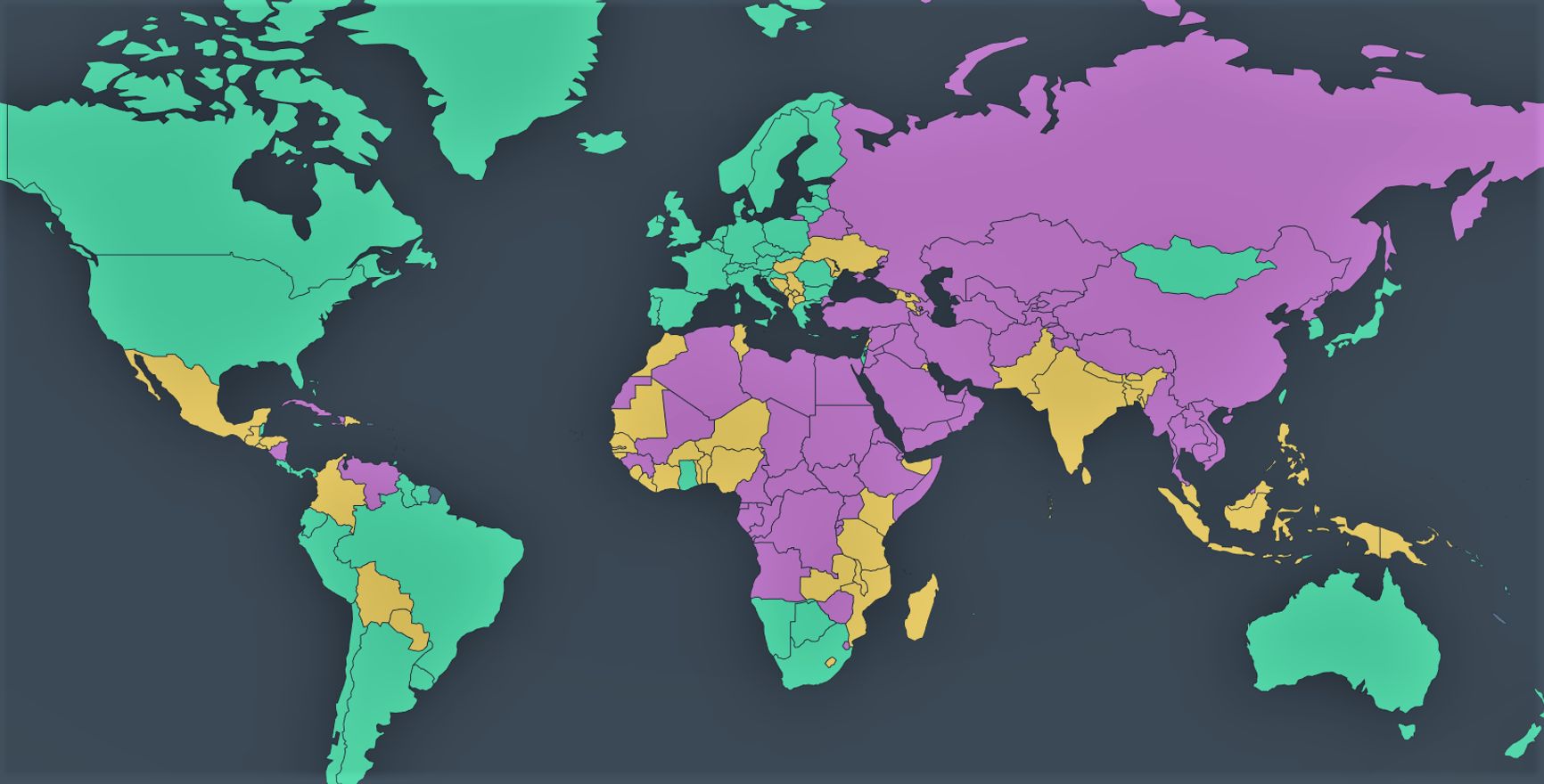
The global freedom map by Freedom House. Green regimes are considered free, yellow regimes are partly free, and purple regimes lack freedoms. Mongolia is surrounded by authoritarian regimes
In its 2022 World Press Freedom Index, Reporters Without Borders (RSF) lowered Mongolia's score, moving the country from 68th to 90th place. However, according to the international NGO, Mongolia is still a liberal democracy that respects the principles of freedom of speech and pluralism of opinion in the media. By comparison, Russia ranks 155th out of 185 countries, and the US ranks 45th. No Mongolian journalists are currently imprisoned for their professional activities.
Mongolia meets many criteria for democracy. It holds regular, competitive elections; the majority of its citizens have the right to vote, and most importantly, election results cannot be reviewed post factum.
Mongolia is a semi-presidential republic in which the legislative power is vested in the government and the parliament. The state and cabinet are currently run by the Mongolian People's Party (MPP), a successor of the communist Mongolian People's Revolutionary Party (MPRP). The MPP also holds the majority of seats in the parliament: 65 out of 76. The MPP’s main rival in the struggle for power is the Democratic Party, even though the country has around twenty registered parties. The high concentration of power in the hands of a single party should not be interpreted as a sign of authoritarianism. As Grigory Golosov, political scientist and professor of the European University at St. Petersburg, explained to The Insider, this imbalance stems from political dynamics characteristic of young democracies. The setting often changes dramatically after elections, the expert clarified:
“Speaking of the parliament's composition, Mongolia has often alternated between a strong majority from one party and a strong majority from another party that used to be in opposition and was not significantly represented in the parliament. This was largely due to the electoral system specifics.”
A case of successful transit
Historically, Mongolia is very close to other Central Asian states with a nomadic past. But unlike its neighbors in the region – Kazakhstan, Kyrgyzstan, Uzbekistan, Turkmenistan, and Tajikistan – it was never part of the Soviet Union. In 1921, Mongolia declared independence but fell under Soviet influence nonetheless. As a result, Mongolia developed as a Soviet-style, single-party political system with the Mongolian People's Revolutionary Party (MPRP) at its core, closely affiliated with the Communist Party of the Soviet Union. Nevertheless, its legal independence from the USSR gave greater autonomy to its government, which may have subsequently contributed to a successful democratic transition.
Public protests calling for democratic reforms began in Ulaanbaatar in the late 1980s in sync with Soviet perestroika. The government gave in, unwilling to disperse the protesters by force. MPRP abandoned the Marxist-Leninist course, changed its charter and structure, removed several Politbureau members, and essentially became a leftist social-democratic force. The former elite largely retained influence but was already operating within a democratic framework in line with democratic principles.
The year 1990 saw a national election that ended in the victory of the reformed and re-branded MPRP: the Mongolian People's Party. The opposition consisted mainly of democratic parties that laid the foundations for the Democratic People's Party in 2000 – the MPP’s main rival to date. Democratic candidates won presidential elections in 2009, 2013, and 2017.
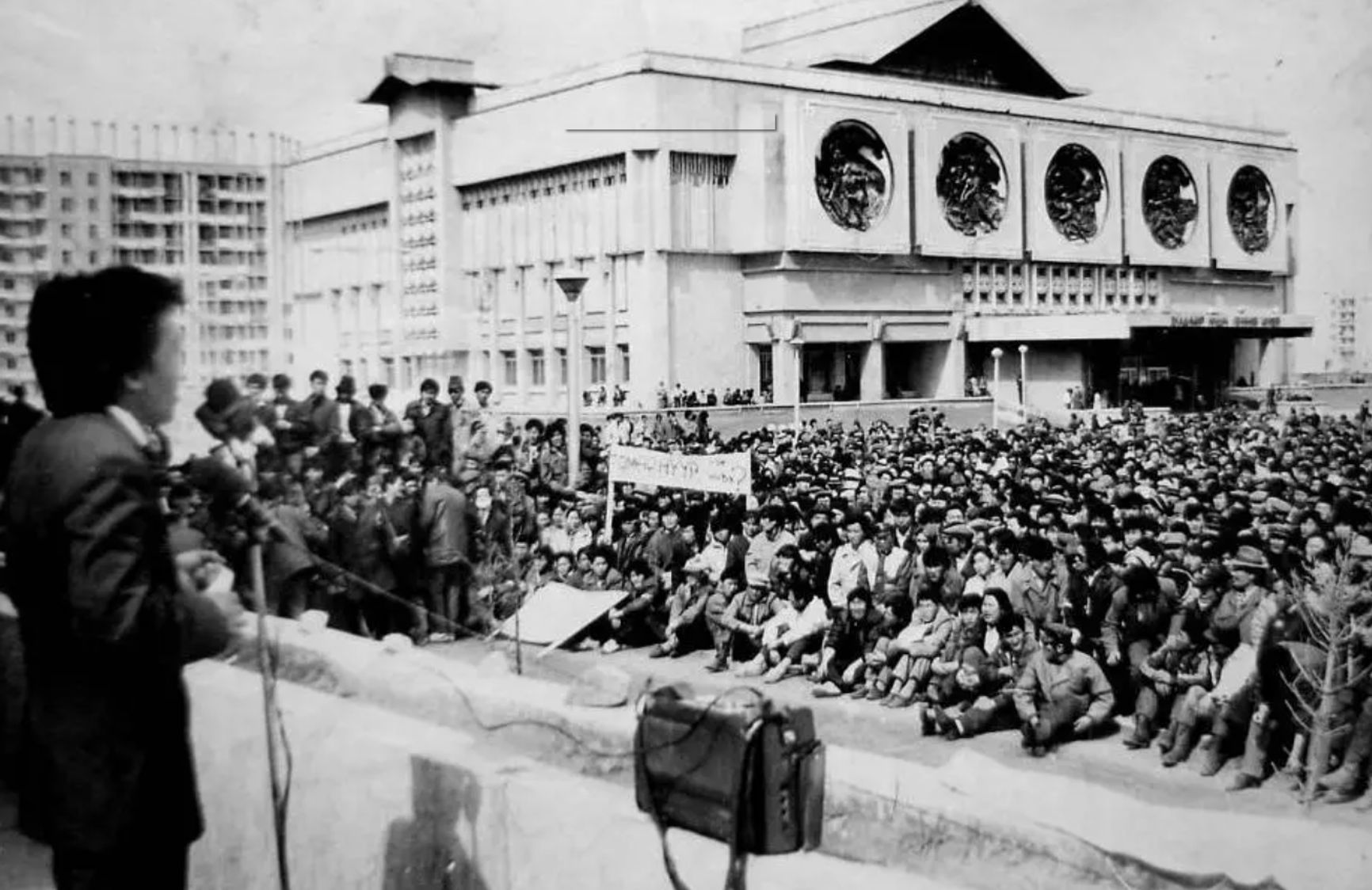
Mongolia, 1990
Prerequisites for democracy
The emergence of a democratic system in Mongolia should not be considered unique, says political scientist Grigory Golosov. As he points out, if we examine the Asian region more broadly, looking beyond Central Asia, we will see successful democracies in the relative vicinity of Mongolia: South Korea and Japan.
In an article published in the Journal of Democracy, American researcher Stephen Fish called Mongolia “a democracy without prerequisites”. In his opinion, Mongolia was better positioned for the emergence of an autocratic regime, and when the USSR disintegrated, nothing foretold the emergence of a democratic system there. From this perspective, Mongolia is an exceptional case.
Margarita Zavadskaya views the emergence of democracy in Mongolia as a unique case of democratic transition in the region. In her opinion, the processes that occurred there would have been more characteristic of Eastern Europe:
“The events unfolded along the same lines as in Central and Eastern Europe up to a certain point. There was a democratic party that won the election, defeating the old guard of communist bureaucracy: the Mongolian People's Revolutionary Party (MPRP). Then the old party regained its standing but changed its outlook. Similar processes with alternating parties took place in the Czech Republic and Poland approximately up to the early 2000s. In Mongolia, they are ongoing, which is quite fascinating.”
According to Zavadskaya, a combination of factors has prevented Mongolia from becoming an authoritarian proxy state. For example, local politicians’ capacity for negotiation may have been one of the prerequisites for the successful emergence of democracy and the general stability of the system, preventing the country from lapsing into authoritarianism, says the political scientist:
“In the 2000s, Mongolia got its first coalition government, which brought together two seemingly irreconcilable parties. These are all signs that political actors can negotiate without resorting to violence, seizing power, or violating procedure.”
Apart from its elites’ ability to find common ground, another reason why Mongolia, unlike its larger neighbors, has established a sustainable democratic system is the lack of resources for full authoritarian control over the entire territory and all political agents. The more authoritarian the government, the more resources, primarily law enforcement and security services, are required to maintain it, Zavadskaya explains:
“The lack of so-called ‘state capacity’, a powerful authority infrastructure, was the reason why not a single Mongolian actor, be it a group of oligarchs or security officials, could pull together the resources and establish the proverbial vertical of power, as it happened in Russia, for one.“
Another reason for Mongolia's democratic successes is its relatively limited historical record of using violence against its people and its rejection of repression as a method of governance. As Margarita Zavadskaya notes, the repressions against Buddhist clergy and intellectuals that took place in Mongolia in the 1930s in parallel with the great terror in the USSR were organized by the Soviet leadership and “outsourced”. The State Internal Guard of Mongolia was built in the image and likeness of the VChK-OGPU (the Joint State Political Directorate of the Soviet Union), and in the early years, almost half of the personnel were Soviet chekists. They were responsible for most acts of repression because local leaders refused to use violence.
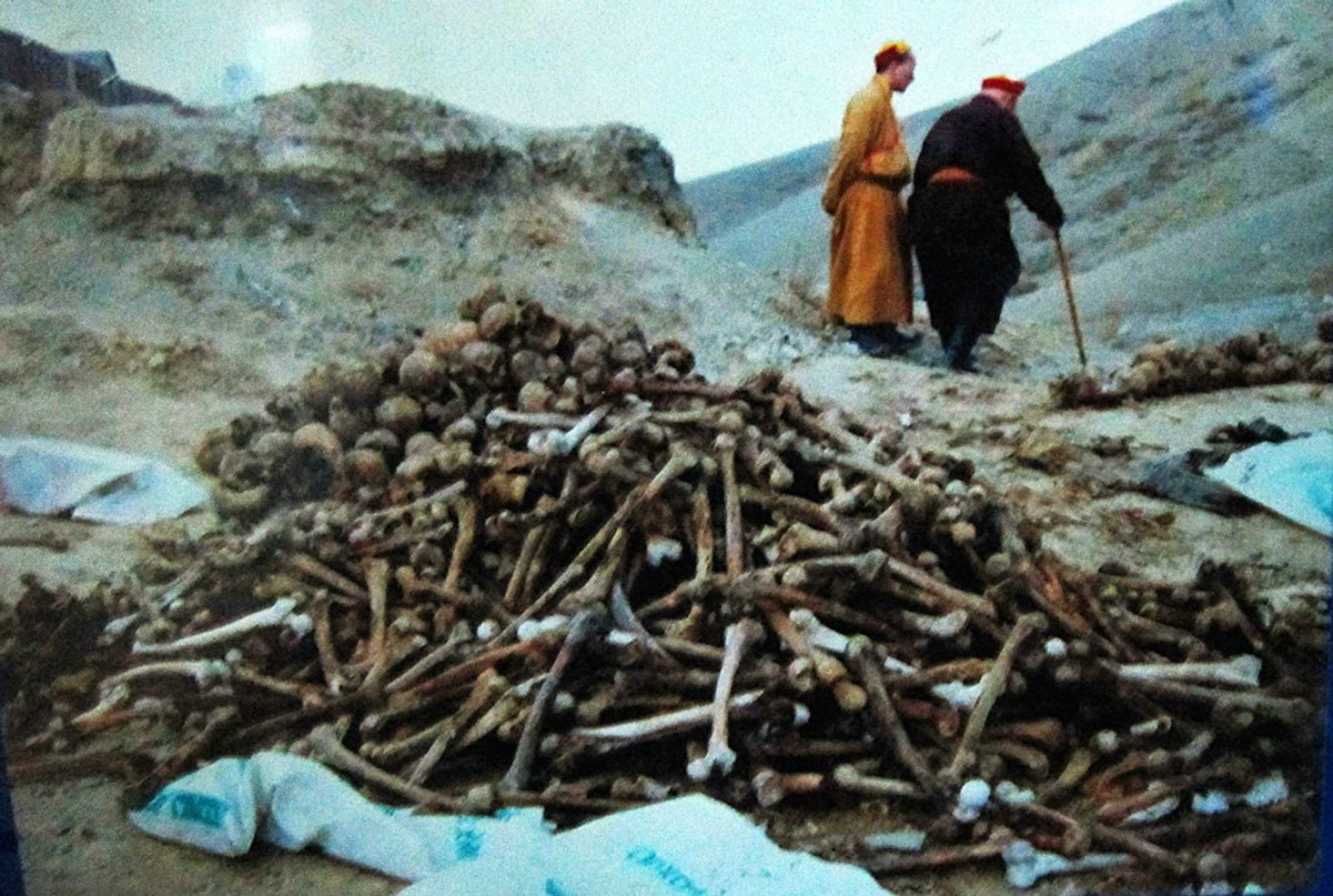
A mass grave of executed Buddhist monks at the Hambyn-ovoo Mountain
Memorial Museum of the Victims of Political Repression, Ulaanbaatar
“Disobedient people with an alternative vision and independence fighters were hanged in Beijing before 1911 and shot in Moscow after 1921,” says Mongolian writer and journalist Baasansuren Tugalkhuugiin. In modern Mongolia, the repression of that period epitomized Soviet totalitarianism and became a “vaccine” against autocracy.
Why democracy is losing ground in Mongolia
Corruption in Mongolia remains one of the greatest threats to democratic development. The country ranks 33rd in the Corruption Perception Index (the higher the value, the less corrupt the state is perceived to be). Over the past decade, Mongolia has even seen a trend toward a slight decline in corruption. Meanwhile, the authorities are using the fight against corruption as a pretext for a crackdown on liberties and weakening of democratic institutions, according to the critics of the current government.
Thus, in 2019, evoking the need to fight corruption, the president sponsored legislative amendments strengthening the control of the executive branch over the judiciary. As a result, the National Security Council, which includes the president, the prime minister, and the speaker of parliament, can now remove judges and heads of anti-corruption agencies pre-term. Shortly after the amendments came into effect, the heads of the country's anti-corruption agency, including the supervisors of an investigation that mentioned the president, resigned.

Mongolia on the Corruption Perception Index map
Transparency International
“The four previous presidents installed their loyal associates as key judges, practically ruining the judicial system,” says journalist Jargalsaikhan Dambadarjaa. He believes that the lines between the legislative, executive, and judicial powers are gradually blurring. About a quarter of Mongolia's legislators are also members of the executive branch, holding positions in the government, Dambadarjaa writes. In his opinion, this could be deemed in bicameral parliaments with hundreds of deputies, but in the small, 76-strong Mongolian parliament, such a situation creates a conflict of interest and threatens the separation of powers.
Furthermore, Mongolia spent several years discussing a bill that would tighten control over non-governmental and non-profit organizations defending public interests and monitoring government agencies’ activities.
“The space for civil society in Mongolia is shrinking, I’m afraid,” explains Sukhgerel Dugersuren, the development specialist and executive director of the Mongolian NGO Oyu Tolgoi Watch. “The state is using tax legislation, requirements for social security and financial reporting, and complex registration procedures to complicate NGOs’ operations. We hear the same narrative about ‘foreign-funded organizations’ interfering in our domestic politics.”
Another issue is the lack of legal leverage for Mongolia's civil society to influence the work of companies extracting natural resources or the oversight bodies that are supposed to control them. This is one of the reasons for the frequent protests of environmental activists in Mongolia. For one, Ulaanbaatar is shrouded in thick smog every winter due to the violation of coal mining regulations.
China – Mongolia – Russia
Mongolia's geographic location between China and Russia serves as a system of checks and balances in which the country appears doomed to neutrality. China’s attempts to interfere in Mongolia's political system are unlikely to succeed because Mongolians are too wary of the PRC authorities, despite their close economic ties, Golosov believes:
“Mongolia’s independence from China was hard-won and was only finalized in 1945, when other states recognized it after a referendum held at the insistence of the USSR. The nation remembers this all too well and is apprehensive of political dependence on China. Not even the strong economic ties with the PRC can overturn this attitude.”
Faced with international isolation and a need for new markets and allies, Russia may try to take advantage of the political instability and attempt to install pro-Russian leaders in Mongolia. Moscow's renewed interest in Ulaanbaatar is evidenced by the more frequent visits of Russian officials and politicians. A delegation of State Duma deputies arrived in the Mongolian capital on January 19, and Russian Foreign Minister Sergey Lavrov paid a visit to President Ukhnaagiin Khurelsukh last July. “It was a diplomatic visit of symbolic value. Nevertheless, Mongolia voted neutrally when it came to approving the sanctions, showing extreme caution,» says Margarita Zavadskaya.

"Russian warship, go f*ck yourself." Graffiti against Putin and the war in the center of Ulaanbaatar. The name “Putin” has been painted over
According to the polls, most Mongolians are strongly opposed to Russian aggression in Ukraine. This factor will further complicate the Kremlin's policy in the region. Many Mongolians are outraged by Russia's attack on a comparatively small neighboring country, which was once its fellow Soviet republic. “At the same time, many do not want to quarrel with Russia, understanding that Mongolia is too small and weak a country to stand a chance in such a conflict,” says Margarita Zavadskaya.
The Mongolians have a special relationship with Buryatia, a Russian constituent republic just across the border. The Buryats speak a similar language, and Mongols perceive them as a “brotherly people” due to strong cultural, economic, and religious ties. In the minds of many Mongolians, relations with Russia are not about the Kremlin; instead, they focus on a kindred Mongolic minority living on Russian territory, Zavadskaya explains.
The residents of Buryatia who fled to Mongolia from mobilization report an increased activity of Russian intelligence and FSB agents in Mongolia. According to The Insider's sources, the security forces are more preoccupied with Russians who fled the draft than with influencing the Mongolian political elite. One can venture to assume, however, that Russian agents may have a different agenda: as recently as June 2021, the Mongolian Supreme Court doled out punishment for two such agents. The Mongolian GRU officers had been passing classified data to the Russian embassy in Ulaanbaatar. Both received 14 years in prison. However, unlike other countries, Mongolia did not expel any Russian diplomats. In light of the above, Mongolian leadership clearly has some reason to be concerned.
The future of Mongolian democracy
The unrest over coal could end in a change of government. Mongolian prime minister Luvsannamsrain Oyun-Erdene proposed a transition from a semi-presidential form of government to a conventional parliamentary republic. He reported on preparations for constitutional reform to that effect. According to him, the 1992 Constitution has met its objectives of a peaceful transition to democracy and the creation of a humane civil society, and now it is time to rewrite or at least amend the fundamental law. Anastasia Tsedenbal, Orientalist historian, member of the Society of Friends of Mongolia, and the granddaughter of Yumjaagiin Tsedenbal, leader of Mongolia from 1952 to 1984, cited the convergence of legislative and executive powers as one of Mongolia's systemic pitfalls. Tsedenbal believes it will probably be the main focus of the upcoming reform:
“The government is made up of members of parliament. What we get is a strong symbiosis of legislative and executive powers, which makes for an imperfect system of checks and balances. I believe we will see this structure reformed in the future.”
The political analysts interviewed by The Insider agree on the absence of preconditions for the autocratization of power in Mongolia. The protesters’ actions and demands are being taken into account, and their constitutional rights have not been violated, Grigory Golosov explained:
“While interpreting their actions as aimed at maintaining law and order, the authorities may in fact be infringing upon constitutional rights. In Mongolia, the government has not crossed that line.”